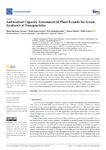Mostrar o rexistro simple do ítem
Antioxidant Capacity Assessment of Plant Extracts for Green Synthesis of Nanoparticles
| dc.contributor.author | Martínez-Cabanas, María | |
| dc.contributor.author | López García, Marta | |
| dc.contributor.author | Rodríguez-Barro, Pilar | |
| dc.contributor.author | Vilariño, Teresa | |
| dc.contributor.author | Lodeiro, Pablo | |
| dc.contributor.author | Herrero, Roberto | |
| dc.contributor.author | Barriada, José Luis | |
| dc.contributor.author | Sastre de Vicente, Manuel | |
| dc.date.accessioned | 2021-09-23T13:06:26Z | |
| dc.date.available | 2021-09-23T13:06:26Z | |
| dc.date.issued | 2021-06-25 | |
| dc.identifier.citation | Martínez-Cabanas, M.; López-García, M.; Rodríguez-Barro, P.; Vilariño, T.; Lodeiro, P.; Herrero, R.; Barriada, J.L.; Sastre de Vicente, M.E. Antioxidant Capacity Assessment of Plant Extracts for Green Synthesis of Nanoparticles. Nanomaterials 2021, 11, 1679. https://doi.org/10.3390/nano11071679 | es_ES |
| dc.identifier.issn | 2079-4991 | |
| dc.identifier.uri | http://hdl.handle.net/2183/28511 | |
| dc.description.abstract | [Abstract] In this work, water extracts from different bio-based products of plant origin were studied to evaluate their antioxidant capacity and their potential to form metal nanoparticles from aqueous solutions. Two traditional tests, the Folin–Ciocalteu assay and the DPPH radical scavenging capacity method were compared with a more recent one, SNPAC, based on the formation of silver nanoparticles. The silver nanoparticle antioxidant capacity method (SNPAC) was optimized for its application in the characterization of the extracts selected in this work; kinetic studies and extract concentration were also evaluated. The extracts were obtained from leaves of oak, eucalyptus, green tea, white and common thyme, white cedar, mint, rosemary, bay, lemon, and the seaweed Sargassum muticum. The results demonstrate that any of these three methods can be used as a quick test to identify an extract to be employed for nanoparticle formation. Additionally, we studied the synthesis of Cu, Fe, Pb, Ni, and Ag nanoparticles using eucalyptus extracts demonstrating the efficiency of this plant extract to form metallic nanoparticles from aqueous metal salt solutions. Metal nanoparticles were characterized by transmission electron microscopy and dynamic light scattering techniques. | es_ES |
| dc.description.sponsorship | This research was funded by Ministerio de Economía y Competitividad through the research Project CTQ2016-80473-P, cofounded with the Agencia Estatal de Investitación and FEDER programme | es_ES |
| dc.language.iso | eng | es_ES |
| dc.publisher | MDPI | es_ES |
| dc.relation | info:eu-repo/grantAgreement/AEI/Plan Estatal de Investigación Científica y Técnica y de Innovación 2013-2016/CTQ2016-80473-P/ES/EMPLEO DE BIOMASA PARA EL DESARROLLO DE NUEVOS METODOS DE SINTESIS DE NANOPARTICULAS MAGNETICAS RECUBIERTAS CON POLIMEROS DE IMPRESION MOLECULAR (MMIP-NP)/ | |
| dc.relation.uri | https://doi.org/10.3390/nano11071679 | es_ES |
| dc.rights | Atribución 4.0 Internacional | es_ES |
| dc.rights.uri | http://creativecommons.org/licenses/by/4.0/ | * |
| dc.subject | Plant extracts | es_ES |
| dc.subject | Agricultural waste utilization | es_ES |
| dc.subject | Antioxidant capacity | es_ES |
| dc.subject | Metallic nanoparticles | es_ES |
| dc.title | Antioxidant Capacity Assessment of Plant Extracts for Green Synthesis of Nanoparticles | es_ES |
| dc.type | info:eu-repo/semantics/article | es_ES |
| dc.rights.access | info:eu-repo/semantics/openAccess | es_ES |
| UDC.journalTitle | Nanomaterials | es_ES |
| UDC.volume | 11 | es_ES |
| UDC.issue | 7 | es_ES |
| UDC.startPage | 1679 | es_ES |
Ficheiros no ítem
Este ítem aparece na(s) seguinte(s) colección(s)
-
GI-METMED - Artigos [10]






